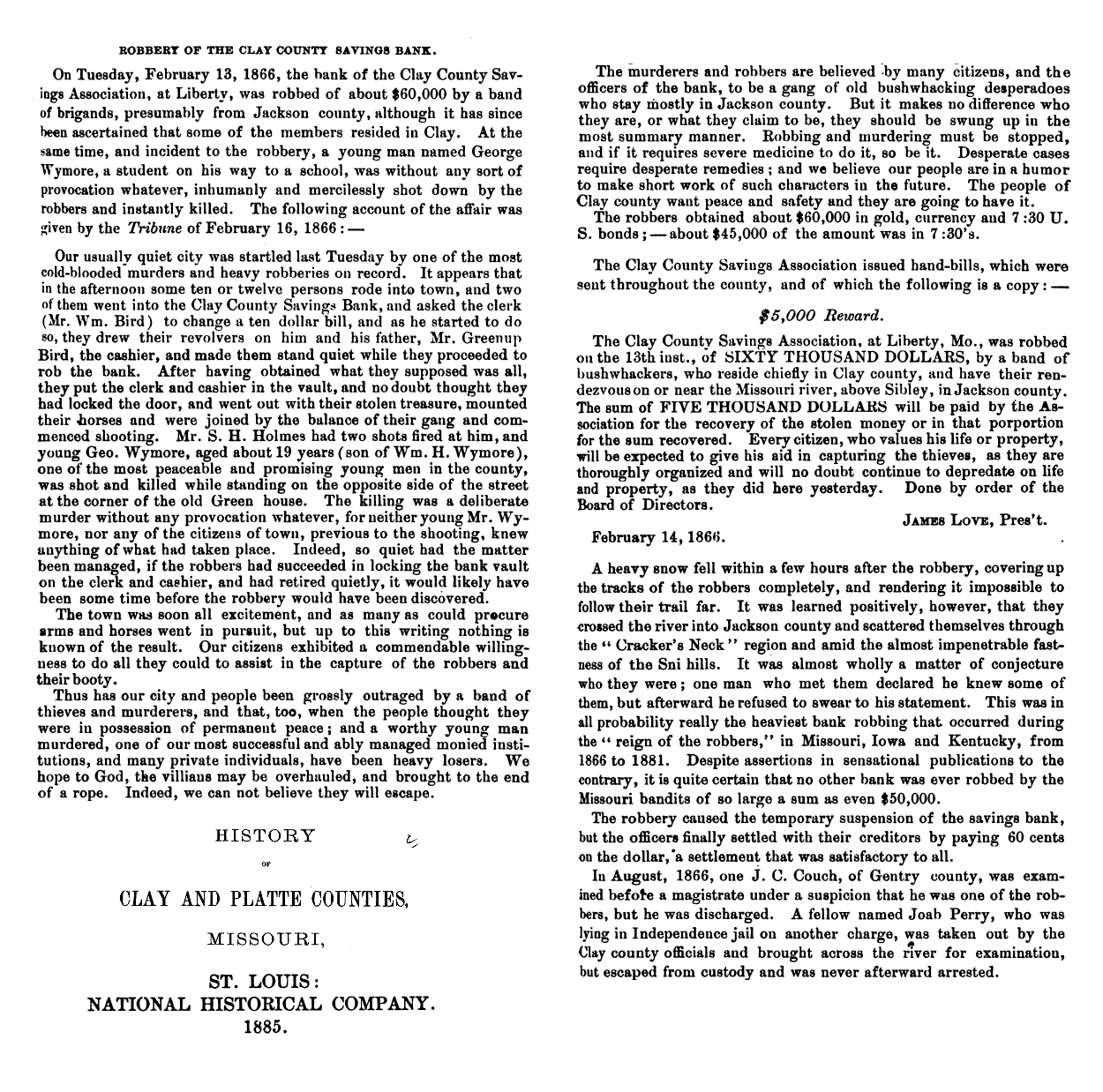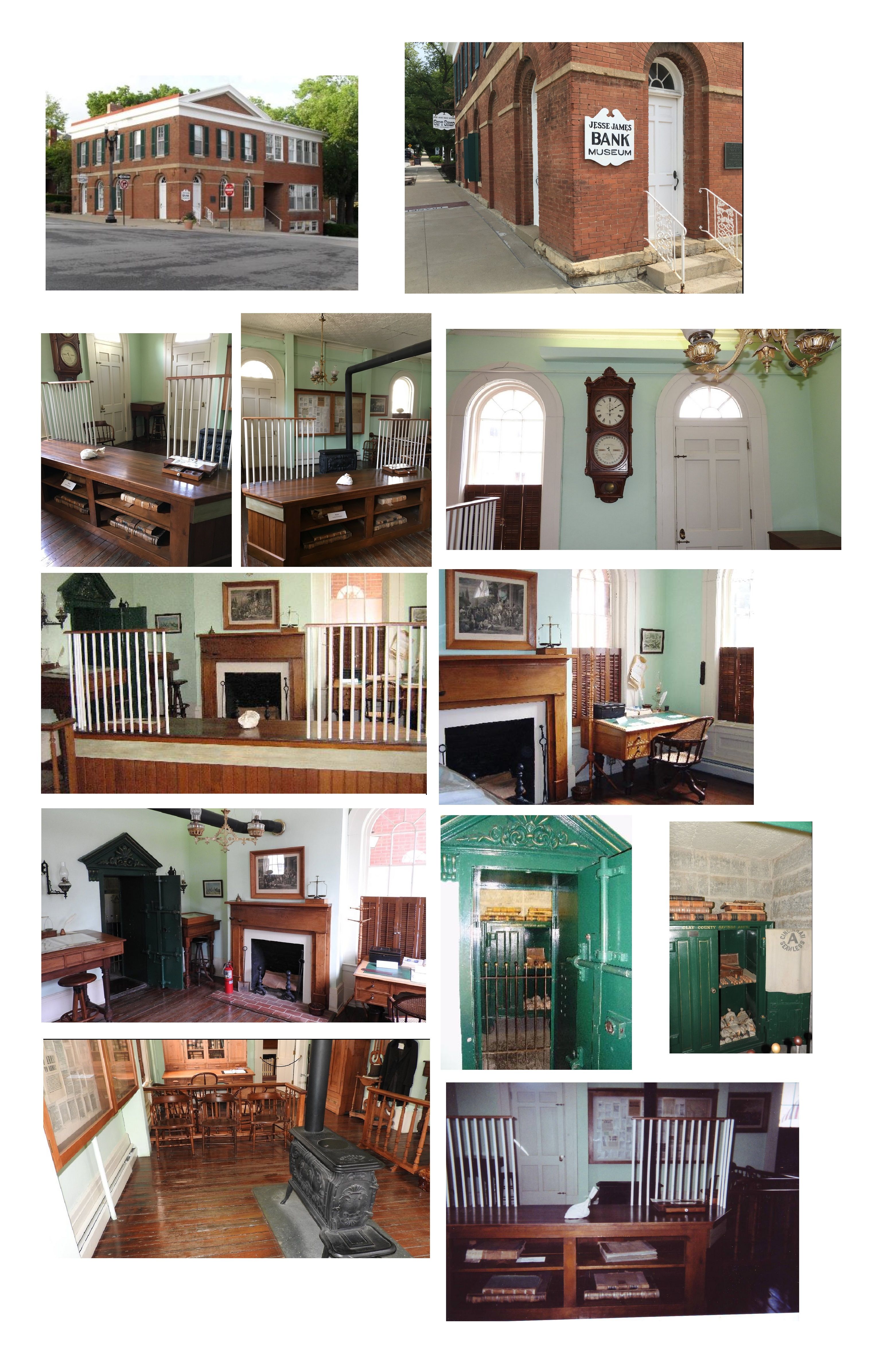Twelve former Confederate bushwhackers, believed to have been members of Quantrill's Raiders and some that later became members of the James-Younger Gang, possibly including Frank James, older brother of the notorious outlaw Jesse James, rode into Liberty from various directions on the cold, snow-crusted afternoon of Tuesday, February 13, 1866. At the time, most of the townspeople were occupied observing a trial. Three of the brigands stood lookout from the outskirts of town, as the rest rode to the bank. Two of the riders dismounted and entered the two-story, brick building at 2 p.m., while the other seven remained on their horses, reportedly appearing nervous.
Working inside the bank were Greenup Bird, 56, head cashier, and his son, William, 22, clerk and Union Civil War veteran (Pvt. in McMillan's Clay County Volunteer Missouri Militia and Sergeant Major, Company L, 4th Provision Enrolled Missouri Militia, Company F, 48th.) During the mid-19th century, a bank head cashier was the equivalent of the manager. The elder Bird wrote an account of the hold-up. He related that the two men entered wearing blue, soldier overcoats and warmed themselves at the stove. One of the men strode towards the counter, asking to negotiate a $10 note, as William Byrd approached to assist him. This would become the gang's "modus operandi" in future robberies. Upon reaching the counter, the robber drew his revolver, pointed it at the young man's head and demanded all the money from the bank.
William stepped back in shock, as the man jumped the counter and ordered him into the vault. The robber handed the clerk a feed sack and ordered him to empty the contents of the safe into the bag. The other robber, with his revolver drawn, also jumped the counter and bore down on Greenup Bird, demanding that he hand-over all the greenbacks. Bird gestured to a money box, and the second robber grabbed the cash, handed it to his accomplice in the vault and ordered Bird to step inside.
Bird hesitated and tried to parley, but soon joined his son in the vault after the robber threatened to shoot him in the head if he didn't do as ordered. With the two bank employees inside the vault, the robber with them quickly moved out with his sack of loot. He ordered the hostages to be still as he shut the vault door, thinking he was locking them inside.
The two robbers exited the building to rejoin the rest of their gang on horseback in the street. Inside the bank, the Birds found the vault door had not been locked and Greenup sprinted to a window, flung it open and yelled an alarm into the freezing air. Some of the robbers began shrieking and shooting wildly, as they spurred their horses and galloped down the street heading east out of town.
Standing across the street adjacent to the Green house (hotel), were two young men, John Reardin and George "Jolly" Wymore, from the town's William Jewell College, where William Bird had recently graduated. Jolly Wymore had been walking to school and stopped to see the commotion. He was shot dead in the heart by one of the gang. There are conflicting reports whether it was intentional or accidental. Another street bystander, S. H. Holmes, was shot through his shawl, but not hit.
And so began the criminal enterprise of The James-Younger Gang. The robbers left the bank with approximately $60,000 (cash, bonds, government revenue stamps and gold) in their feed sack. Although folklore has long held that Jesse James led the robbery, that has never been established. This much is clear: the robbery was never solved, none of the plunder recovered and no man stood trial for robbery or the murder of Jolly Wymore.
At $60,000, it stands as the largest loss by far during the peak period of bank and train robberies in Missouri and the Midwest, from 1866 to 1881. The Liberty Savings Association failed as a result of the robbery and ultimately paid its depositors and creditors $.60 on the dollar following its liquidation.
Local newspapers furthered the belief that the robbery was the work of former Confederate guerrillas, others sources speculated that the robbers were from Kansas, so called Redlegs who had been supportive of the Union cause during the recently concluded Civil War. At the time of the robbery Jesse James was bedridden as he recovered from a chest wound at his family homestead in Kearney, MO. While it is likely that most of the robbers were members of the eponymous gang of thieves and murderers that James soon rode with, there is scant likelihood that Jesse James was at Liberty that cold, February afternoon.
The family of slain "Jolly" Wymore, has passed down the story, that within a few weeks they received a letter apologizing for the death of the boy, and stating that no one was supposed to be harmed. Today the bank building is owned and operated as a museum by Jack Wymore and his family, the sixth generation to live in Clay County Missouri.
George Wymore's sister is also buried in this cemetery, and her grave is also unmarked. George's headstone had been missing for many years when out of the blue a woman phoned Jack Wymore one day and offered him his ancestor's grave marker. It had been turned upside down and used as a door stop at her family farm for many years before the woman discovered what it was. The headstone is now at the Wymore family's Jesse James Museum in Liberty Missouri. Information on the location of the cemetery, which is on private property, was provided by Jack Wymore.
Updated biography by John Donne
Twelve former Confederate bushwhackers, believed to have been members of Quantrill's Raiders and some that later became members of the James-Younger Gang, possibly including Frank James, older brother of the notorious outlaw Jesse James, rode into Liberty from various directions on the cold, snow-crusted afternoon of Tuesday, February 13, 1866. At the time, most of the townspeople were occupied observing a trial. Three of the brigands stood lookout from the outskirts of town, as the rest rode to the bank. Two of the riders dismounted and entered the two-story, brick building at 2 p.m., while the other seven remained on their horses, reportedly appearing nervous.
Working inside the bank were Greenup Bird, 56, head cashier, and his son, William, 22, clerk and Union Civil War veteran (Pvt. in McMillan's Clay County Volunteer Missouri Militia and Sergeant Major, Company L, 4th Provision Enrolled Missouri Militia, Company F, 48th.) During the mid-19th century, a bank head cashier was the equivalent of the manager. The elder Bird wrote an account of the hold-up. He related that the two men entered wearing blue, soldier overcoats and warmed themselves at the stove. One of the men strode towards the counter, asking to negotiate a $10 note, as William Byrd approached to assist him. This would become the gang's "modus operandi" in future robberies. Upon reaching the counter, the robber drew his revolver, pointed it at the young man's head and demanded all the money from the bank.
William stepped back in shock, as the man jumped the counter and ordered him into the vault. The robber handed the clerk a feed sack and ordered him to empty the contents of the safe into the bag. The other robber, with his revolver drawn, also jumped the counter and bore down on Greenup Bird, demanding that he hand-over all the greenbacks. Bird gestured to a money box, and the second robber grabbed the cash, handed it to his accomplice in the vault and ordered Bird to step inside.
Bird hesitated and tried to parley, but soon joined his son in the vault after the robber threatened to shoot him in the head if he didn't do as ordered. With the two bank employees inside the vault, the robber with them quickly moved out with his sack of loot. He ordered the hostages to be still as he shut the vault door, thinking he was locking them inside.
The two robbers exited the building to rejoin the rest of their gang on horseback in the street. Inside the bank, the Birds found the vault door had not been locked and Greenup sprinted to a window, flung it open and yelled an alarm into the freezing air. Some of the robbers began shrieking and shooting wildly, as they spurred their horses and galloped down the street heading east out of town.
Standing across the street adjacent to the Green house (hotel), were two young men, John Reardin and George "Jolly" Wymore, from the town's William Jewell College, where William Bird had recently graduated. Jolly Wymore had been walking to school and stopped to see the commotion. He was shot dead in the heart by one of the gang. There are conflicting reports whether it was intentional or accidental. Another street bystander, S. H. Holmes, was shot through his shawl, but not hit.
And so began the criminal enterprise of The James-Younger Gang. The robbers left the bank with approximately $60,000 (cash, bonds, government revenue stamps and gold) in their feed sack. Although folklore has long held that Jesse James led the robbery, that has never been established. This much is clear: the robbery was never solved, none of the plunder recovered and no man stood trial for robbery or the murder of Jolly Wymore.
At $60,000, it stands as the largest loss by far during the peak period of bank and train robberies in Missouri and the Midwest, from 1866 to 1881. The Liberty Savings Association failed as a result of the robbery and ultimately paid its depositors and creditors $.60 on the dollar following its liquidation.
Local newspapers furthered the belief that the robbery was the work of former Confederate guerrillas, others sources speculated that the robbers were from Kansas, so called Redlegs who had been supportive of the Union cause during the recently concluded Civil War. At the time of the robbery Jesse James was bedridden as he recovered from a chest wound at his family homestead in Kearney, MO. While it is likely that most of the robbers were members of the eponymous gang of thieves and murderers that James soon rode with, there is scant likelihood that Jesse James was at Liberty that cold, February afternoon.
The family of slain "Jolly" Wymore, has passed down the story, that within a few weeks they received a letter apologizing for the death of the boy, and stating that no one was supposed to be harmed. Today the bank building is owned and operated as a museum by Jack Wymore and his family, the sixth generation to live in Clay County Missouri.
George Wymore's sister is also buried in this cemetery, and her grave is also unmarked. George's headstone had been missing for many years when out of the blue a woman phoned Jack Wymore one day and offered him his ancestor's grave marker. It had been turned upside down and used as a door stop at her family farm for many years before the woman discovered what it was. The headstone is now at the Wymore family's Jesse James Museum in Liberty Missouri. Information on the location of the cemetery, which is on private property, was provided by Jack Wymore.
Updated biography by John Donne
Bio by: Bill Walker
Family Members
Advertisement
Records on Ancestry
Advertisement


















